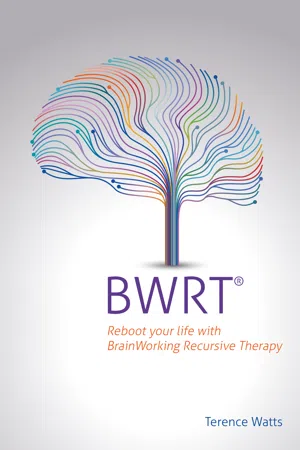7 Chapter 1
Just Who Makes Up Your Mind?
Ever knocked something off a shelf with one hand and caught it with the other without thinking? Even if you weren’t quite quick enough, that other hand probably still gave it a shot before you knew it. You don’t think about it and don’t even know you’re going to do it – and although it might not make much sense at this stage, you’ve just read about the key to almost every psychological problem you will ever experience; a special part of your brain starts to do stuff before you know it.
Now, you might think we’re talking here about that rather mysterious entity, the subconscious. Well, there’s a very odd truth about the subconscious – it doesn’t actually exist, so you can’t send your thoughts to the part of you that so many self-help books and various therapies need you to work with. You can think of your nose or your left big toe (and probably just did) but as soon as you try to think about the subconscious, you end up with either a dark mysterious place full of secrets that you don’t even know about or a shadowy version of you that’s not too keen on letting you know what’s going on there – and even less keen on making permanent change. 8
The term subconscious was coined in 1889 by the French psychologist Pierre Janet – probably to refer to the fact that there is definitely something going on in the psyche, beneath the level of conscious thought. Over the last 130-odd years it has become almost a buzz word for anything to do with uncomfortable or unwanted behaviour or thoughts because there was nothing better to call it. It’s used as a matter of course by psychiatrists, psychologists and just about anybody interested in or working with the human mind. Nonetheless, it’s really nothing more than an idea – a concept – and certainly not a physical part of the body that we can send our thoughts to or try to manipulate; and manipulation is definitely needed if you want to make huge and fast changes to the way you function in the world.
So, if it’s not the subconscious that does all that under-the-counter stuff, what is it? Well, it’s almost certainly a truly physical part of the body – the lizard brain, sometimes referred to as the reptilian complex (which this book will do from now on). This ancient part of the brain came into being, as far as anyone knows, over 600 million years ago, in some of the earliest animals on Earth. It was actually the only brain they had and it had to do absolutely everything: looking after the vital processes like circulation, respiration, digestion, body repairs and everything else. Back then, of course, everything else was pretty much just feeding and breeding – and staying alive in order to do more of the other two.
You might now be wondering what on earth this has to do with catching a vase you’ve just knocked off a shelf. Well, a lot more than you might think. You see, those early animals were creatures of instinct and nothing more. They lived or died by the accuracy of those instincts – it was nothing to do with weighing up a situation and assessing the best response. There wasn’t time for any of that and survival depended purely on an instinctive response to a threat: run like the devil or fight like a demon; try to escape the enemy or try to kill it before it kills you. That bit of the brain is a lot older than conscious thought and far, far quicker. It was the first responder to life and all there was for well over 550 million years, during the later part of which evolution had seen to it that some animals had developed a more sophisticated process capable of a wider range of emotional responses. And then, only around 3 million years ago, the biggest part of the brain – the cerebral cortex – appeared, purportedly in the early humans. But that 9reptilian complex still remains the first responder – it can’t not, because evolution just doesn’t dump anything that works, especially when it works as well as that early brain.
So, it’s still there in all of us, checking our surroundings for threat 24/7 just as it always has done. But it does something else, too. It learns how we respond to repeated actions and creates an instinctive response that it will automatically trigger when it recognises the relevant pattern of events or circumstances. That response is activated immediately, just as it would have been with those early animals millions of years ago. But the brain doesn’t work anywhere near as fast as you might imagine and we don’t become aware of what’s going on until about half a second later, by which time it’s already happening and we’ve saved that vase from smashing to bits. Later, we refer to that half-second as the cognitive gap and it’s there that we make changes.
Of course, if that bit of the brain has triggered anxiety (or any other unwanted response) for some reason, it will already be happening by the time we become aware of it – which is exactly why it can be so difficult to get control of. And as to why it would do that, it’s because it recognised something that used to be a threat; it might not be so now, but nobody told the reptilian complex that. There are many other responses but they all come down to the same thing: that reptilian complex has spotted a pattern to which it has a response that must be activated because it’s there.
You don’t have free will, but you do have free won’t. What this means is that you can sometimes decide not to act on an instinctive reaction (so you decide not to eat that scrumptious-looking cream cake) but you can’t stop the urge from occurring in the first place. The reptilian complex has learned that you love cream cakes and so the urge to eat it pops up immediately – and it might be swiftly followed by a determination not to because the reptilian complex has also learned that you don’t want to respond to that first urge. And in case you’re wondering, the first urge has to occur so that the second one, of determination, can arise because it has linked them together. 10
You’re probably beginning to understand why making changes to what used to be called the subconscious is so difficult. But BWRT makes it a lot easier, as you’ll see later.
Just be yourself
You might have been given the advice many times to just be yourself or, more recently, have experienced some well-meaning individual saying you just have to be authentic and the world will be yours. Well, there’s a big problem there, in that those who tell you those things are themselves not being themselves or authentic. It’s just a soundbite. It somehow sounds and feels right but laws, social requirements and moral codes make it impossible. If you were to be authentic you would follow your instincts and urges and needs as they arose (we all have them) and ignore those social, legal and moral restrictions, no matter where you were – and you can probably work out what sort of outrage that would cause from time to time.
It is a fact that even when they would not be out of bounds, your instincts might not necessarily be good instincts. The reptilian complex just learns behaviour patterns that are often repeated, and in that part of your brain the notion of good and bad or better and best just doesn’t exist. It’s just data with no emotion or value judgement of any sort. That part of the brain doesn’t think or reason; it just recognises a pattern and responds with what it did before. That’s all. After all, if what it did led to survival, which it clearly did because you’re still here, then just do the same again to survive some more and never mind the consequences. Here are some instincts that do little to improve the lives of those who have them (we’re ignoring where they might have come from here):
- Men with beards are dangerous (pogonophobia).
- Spiders are massively frightening (arachnophobia).
- I’m inferior to most people.
- Everybody thinks I’m odd or weird.
- I’m jinxed – everything goes wrong.
- I am better than everyone else.
- I can do what I like – nobody should tell me what to do.
So, if your reptilian complex has learned that social situations are the source of excruciating embarrassment, for example, then it will create anxiety every time you even think about dinner parties (or anything similar) so 11that you develop social phobia. On the other hand, if it has learned that you can’t function very well on your own, you might develop separation anxiety and become a rather clingy individual. The reptilian complex doesn’t question anything – if it encounters something new, it will store it along with any reaction. If you see a spider when you’re very small, you might just be curious – and that’s the response that will be filed. But if, later, you see a spider and an adult runs from it screaming blue murder, the caveat life threatening will be added to the stimulus spider, completely overriding curious on the grounds that it’s a threat to survival.
Just about everything you know is like that, based on some experience or another not necessarily personal; you know crocodiles are dangerous, and would probably panic if you found yourself in the water with one, but the only experience of that situation is almost certainly just what you’ve been told. You can imagine what it would be like to be so rich you could have everything you want but only because you’ve been told about it, perhaps in a film. Most of what you know therefore is based on what somebody else has told you of their own experience. The reptilian complex cares not one jot about that and the more times you hear/see it, the stronger the belief is that it must be so. This is the basis upon which you learn every single thing in life. It’s why, if you come up against something you just don’t recognise, you stop for a moment while you try to find out more about it. Maybe only for a fraction of a second, but you still stop. And that stop is vitally important to BWRT, as you will shortly see. Before we get to that though, there’s something else to get your head around – and it might be something of a surprise.
A simple bit of kit
Everybody knows the brain is the most complex thing in the entire universe, right? Physically, that’s definitely the case. It has around 86 billion neurons, ...





